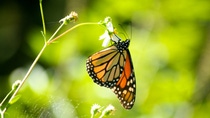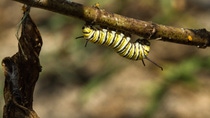Media
BASF teams up with farmers, golf courses to revive monarch butterfly population
The chemical company shows how biodiversity can coexist alongside modern agriculture.

Remember as a child, when you played outside in the summer, your restless eyes would fixate on one amazing creature—the big, bright black and orange butterfly flying about, then suddenly it would sit on a flower. That’s when you’d quickly run after it, attempting to catch it, but you never could. Today, it’s almost impossible to imagine that your children or grandchildren might not get to experience the same in a few years.
Populations of the monarch butterflies have plummeted by approximately 90 percent in the last 20 years and continue to decline, according to latest research. Due to inclement weather in Mexico, the annual population report for Danaus Plexippus shows a 27 percent decrease in 2017 from the previous year's population.
“That’s a red flag and researchers who study the conservation of monarchs say that it’s going to take all of us pitching in to change this trend,” said Karli Moore, Ag Professional Development Program, BASF, in an interview.
What makes these North American species unique is that most of them fly north from central Mexico in spring and summer, up through central and eastern parts of the U.S. and even into Canada over the summer. During the migration, adult female monarchs lay eggs solely on milkweed plants. When the eggs hatch, the resulting larvae feed on milkweed leaves.
As this iconic creature’s existence continues to be in jeopardy, research points to three reasons for the population decline:
· Habitat interference in Mexico (where they spend their winters)
· Climate change and severe weather, such as the extended drought in Texas during their migration through the Lone Star state, which makes it difficult for adult butterflies to find milkweed and nectar plants
· Loss of milkweed habitat, since milkweed, a warm-season perennial, is the sole plant that caterpillars eat
Some skeptics have honed in on the third point and say that agriculture is responsible for the milkweed loss due to new technology and effective control measures used by growers in getting weeds out of crop areas. That’s when BASF stepped in and decided to be part of the solution.
“Due to a perception that habitat loss was responsible for declining populations, we felt it was important to determine how the agricultural community could develop additional habitat in non-crop areas,” said Burleson Smith, Regulatory Affairs Manager, BASF, who’s been involved in this project from the start.
BASF launched a biodiversity research initiative called Living Acres two years ago in Holly Springs, N.C., in hope of increasing the monarchs’ population by planting milkweed in non-crop areas, such as ditches, roadsides, alleyways and border areas. The objective was to provide information to farmers about planting milkweed in non-crop areas in an economic and practical manner. BASF followed up this effort by spreading the word on social media this year and launching the Monarch Challenge on Facebook, encouraging farmers to sign up to receive a free milkweed starter kit and grow the plants to increase biodiversity. More than 1300 farm families signed up, exceeding BASF’s 500 goal for the year. BASF sent out 500 milkweed starter kits, consisting of 18 milkweed seedlings, which totaled 9,000 milkweed seedlings this year.
Aside from being a monarch larvae’s sole food, milkweed is also slightly toxic to most animals and insects, save for the monarchs, who metabolize it and incorporate it into their bodies, which protects them from danger. Research efforts have shown much better long-term success when milkweed plots were started with seedlings or root cuttings rather than seeds, according to Laura Vance, Living Acres Biology Representative, BASF.

As BASF’s initiative continues to gain more traction and corporations, such as agricultural company CHS, and universities started getting involved, the chemical company decided to go the extra mile and extend the Monarch Challenge to professional and specialty solutions businesses, such as turf grass customers. In June, the challenge included its first golf course—North Carolina State University’s Lonnie Poole. Volunteers from the college and BASF’s crop protection division in Raleigh collaborated to plant a variety of milkweed plants.
“Golf courses have ample opportunity to create quality habitat for pollinators and monarchs,” Moore added. “They cover large amounts of area and they already have the capacity to maintain their ground, so approaching them about small changes, like adding milkweed and nectar plants is not an issue.”
About 750 milkweed plants and wildflowers were planted in low-impact areas of the golf course in hopes of establishing monarch habitat.
BASF’s goal with this initiative is to show how modern agriculture can coexist with refuges for monarchs and play an important role in promoting biodiversity of wildlife future generations.
“Now when I look at a garden, I see it totally different than I did before,” Vance added. "I look at which insects are on which flower, and then where are they going. It connects you more with this larger cycle.”

Published by Anna Spiewak.
For media inquiries or to repurpose this article, please contact Lisa Brown.